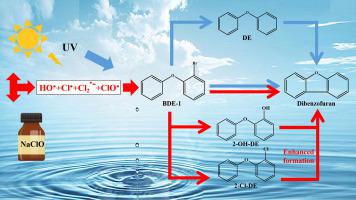Chemical Engineering Journal ( IF 13.3 ) Pub Date : 2020-11-04 , DOI: 10.1016/j.cej.2020.127620 Xinyi Zhang , Dongbin Wei , Yuguo Du

|
Polybrominated diphenyl ethers (PBDEs) are a group of flame retardants which are frequently detected in the aquatic environment. PBDEs would convert into intermediates during some natural or artificial processes. A simple PBDEs congener, 2-bromodiphenyl ether (BDE-1), was targeted, and its transformation characteristics during combined UV-chlorine treatment were investigated in this study. It was found that BDE-1 could rapidly transform in combined UV-chlorine process, and HO• was the predominant radical that contributed to BDE-1 degradation in ultrapure water system. The formation of toxic dibenzofuran (DF) and 2-hydroxydibenzofuran (2-OH-DF) was significantly promoted in combined UV-chlorine treatment, whose total yield (2.78%) was 1.46 times to that in UV treatment alone. Radical scavenger tests revealed that enhanced formation of DF-type products in combined UV-chlorine treatment was attributed to radical reactions. Cl• or HO• generated from free available chlorine photolysis reacted with ortho-carbon radicals generated from BDE-1 photolysis, and produced intermediates 2-chlorodiphenyl ether (2-Cl-DE) or 2-phenoxyphenol (2-OH-DE), which underwent intramolecular elimination of HCl or H2O and formed DF and 2-OH-DF. The treatment with alkaline conditions, high chlorine doses and strong irradiation would be beneficial to the less formation of DF-type products. Besides, the matrix effects of ambient water also inhibited the formation of DF-type products. Overall, this work would provide an insight into the role of free radicals in dibenzofuran formation during combined UV-chlorine treatment on PBDEs and a scientific reference for optimizing operational parameters in the water treatment.
中文翻译:

在单取代二苯醚上进行的紫外线-氯气联合处理期间,自由基促进二苯并呋喃的形成
多溴联苯醚(PBDEs)是在水生环境中经常检测到的一组阻燃剂。在某些自然或人工过程中,多溴二苯醚会转化为中间体。以简单的多溴二苯醚同系物2-溴二苯醚(BDE-1)为目标,并研究了其在紫外线-氯气联合处理过程中的转化特性。结果发现,BDE-1可以在紫外-氯结合过程中迅速转变,而HO•是导致BDE-1在超纯水系统中降解的主要自由基。UV-氯联合处理显着促进了有毒二苯并呋喃(DF)和2-羟基二苯并呋喃(2-OH-DF)的形成,其总收率(2.78%)是仅UV处理的1.46倍。自由基清除剂测试表明,在联合紫外线-氯处理中,DF型产物形成的增加归因于自由基反应。由游离氯光解产生的Cl•或HO•与BDE-1光解产生的邻碳自由基反应,生成中间体2-氯二苯醚(2-Cl-DE)或2-苯氧基苯酚(2-OH-DE),进行了分子内的HCl或H去除2 O并形成DF和2-OH-DF。用碱性条件,高氯剂量和强辐照处理将有利于减少DF型产物的形成。此外,环境水的基质效应也抑制了DF型产物的形成。总体而言,这项工作将提供对自由基在多溴联苯醚的联合UV-氯处理过程中二苯并呋喃形成中的作用的了解,并为优化水处理中的操作参数提供科学依据。











































 京公网安备 11010802027423号
京公网安备 11010802027423号